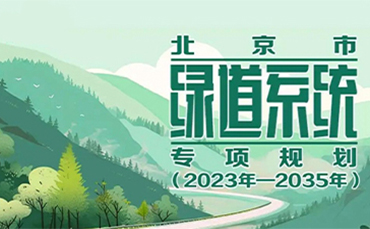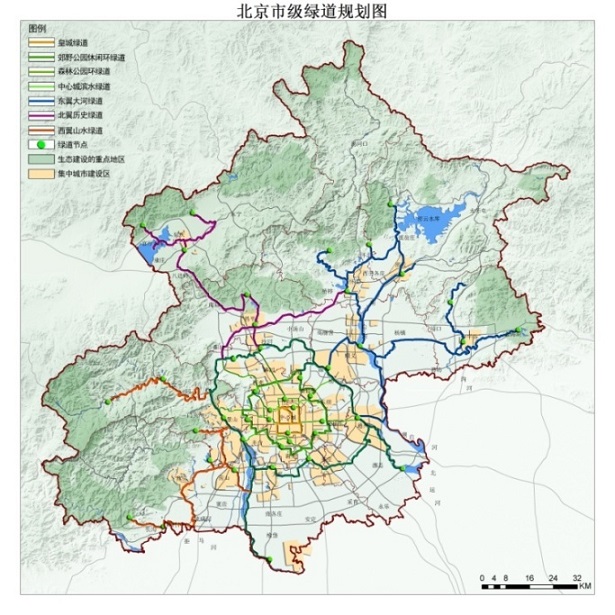



Photo source: <https://fgw.beijing.gov.cn/fgwzwgk/zcjd/201912/t20191226_1505418.htm>
Recently, the "Special Plan for the Greenway System of Beijing (2023-2035)" jointly organized and compiled by the Beijing Municipal Planning and Natural Resources Commission and the Municipal Bureau of Parks and Greening (hereinafter referred to as the "Plan") has been approved by the municipal government. The "Plan," guided by Xi Jinping’s Thought on Socialism with Chinese Characteristics for a New Era and led by the "Beijing City Master Plan (2016-2035)," adheres to the principle of people-centered high-quality development of the capital city. It aims to construct a greenway network at all levels with a total length of over 5,000 kilometers, serving as an important framework of the garden city, connecting the central urban area, plain areas, and mountainous areas. Following the mountains and rivers, it allows residents to enjoy the "Beijing Greenway" services, where green spaces are visible and easily accessible everywhere.
Providing green public product that benefits residential wellbeing
The "Plan" fully utilizes multi-source big data analysis to create user demographics profiles and map user behavior patterns mobile positioning data. This allows for the identification of hotspots and routes popular among citizens for walking and cycling, enabling the rational planning of greenway routes tailored to the needs of different demographic groups such as the elderly, young people, and families. For satisfying various usage scenarios and user needs, the plan consists of a variety of greenway functional types, including off-road cycling greenways, hiking, and mountaineering greenways, family-friendly greenways, educational and cultural greenways, commuting greenways, cultural heritage greenways, and rural leisure greenways. These types will continue to be enriched based on the ongoing demands of the citizens.
Constructing a multi-channel integrated, multifunctional, and dual-use greenway system
Adhering to the principles of co-construction, sharing, openness, and inclusiveness, the proposed plan integrates linear public spaces such as leisure greenways, waterfront slow transportation systems, tourist and leisure trails, forest trails, and urban slow transportation systems into the greenway system. Through high-quality construction, greenway transformation, and other diverse methods, it continuously expands the carrying capacity of the greenway.
In addition to ecological landscapes, recreational activities, sports and fitness, and low-carbon travel, it further expands the functional connotations of greenways by integrating cultural perception, communication and exchange, vibrant consumption, emergency shelter, and biodiversity protection.
The "Plan" also suggests leveraging the dual-use advantages of the greenway system. For example, in mountainous areas, greenways should be coordinated with fire prevention and isolation belts. During normal times, they serve as leisure paths and require strengthened management for various activities. In case of disasters, they serve as evacuation and firefighting routes. This dual-use approach needs to be effectively transformed to ensure regular management and effective emergency response. This enables the greenway system to function as an essential network for the garden city during normal times and as a crucial emergency evacuation routes during emergencies, contributing to the resilience of the city.
Branding Beijing’s cultural heritage and constructing ten city-level branded greenways
The "Plan" proposes to establish the "Jinghua Greenway" with the goals of exploring cultural contexts, displaying mountain and water landscapes, and creating a green rhythm that embodies the essence of Beijing. The establishment of greenways is closely integrated with key areas such as foothill regions and green isolation zones, as well as significant initiatives like the application for World Heritage status for the Central Axis and the connectivity of greenways along the Second Ring Road. Leveraging the city's most culturally rich, ecologically significant, and spatially characteristic regions, the focus is on enhancing the greenway service levels in the "Four Centers" functional areas. Additionally, it encourages the inclusion of distinctive district-level and community greenways, fully harnessing the brand value of the "Jinghua Greenway" to show Beijing’s beauty as a global city.
The Second Ring Road Greenway, as the greenway with the most ancient capital historical and cultural charm, connects important nodes such as the Ming City Wall Ruins Park, Jinchengdu Park, Yonghegong-Lama Temple-Beijing Confucius Temple-Ditan Park, and Tiantan Park. With a planned length of approximately 33 kilometers, about 27 kilometers have already been completed. In the future, through the greenway transformation of the existing five breakpoints in the urban slow transportation system, the entire line will be connected, allowing citizens to enjoy walking and cycling in the lush atmosphere of Beijing's cultural heritage.
The Suburban Park Greenway, relying on urban important blue-green spaces such as the Wenyu River, the Grand Canal, the Liangshui River, the Beigong Forest Park, and the Western Mountain Scenic Area, is positioned as a hundred-kilometer characteristic cycling route and the most beautiful water and forest experience route. With a total length of approximately 200 kilometers, more than half of the construction length has been completed. In the future, with the implementation of the reduction and improvement plan in the Suburban Park area, approximately 49 kilometers of new greenways and approximately 46 kilometers of greenway transformations will be accelerated, providing citizens with rich experiences such as water activities, park visits, hiking, and city viewing.
Enhance the quality of services within the greenway system with both standardization and place-based design
Pathways, facilities, and landscaping are the fundamental components of greenway functionality and directly reflect the quality of service within the greenway system. The "Plan” proposes strengthening the unified configuration and design of city-level greenways, emphasizing service standardization and recognizability. It encourages the personalization of district-level and community greenways, and advocates for adaptive greenway transformations based on local conditions. Additionally, the "Plan" provides classification guidance for the paving materials of pathways in different regions, emphasizing the importance of ecological conservation and closeness to nature, while optimizing the color and materials of pathway surfaces.
Accelerate the implementation of the plan
The "Plan" proposes a ten-year working plan with year one and year three as milestones. This will be accomplished through the establishment of long-term mechanisms, as well as detailed project planning and implementation based on project type, region, and annual targets. This year, the focus will be on the construction of the first phase of the park-greenway loop in green separation areas (Chaoyang section), as well as the Western Mountain Greenway (Shijingshan section). Additionally, the "Plan" suggests accelerating the formulation of a three-year action plan for the construction of the city-wide greenway system, closely aligning with the construction of the Capital's Garden City. It will also establish a key construction project database for greenways, continuously enhancing the sense of acquisition, happiness, and security among the people.
Source: <https://www.planning.org.cn/news/view?id=15502>
Translated by Xiong Yuxi